
A simple remote control tester circuit diagram

This device functions as a convenient tool for testing infrared (IR) remote control transmitters used with televisions, VCRs, and similar devices. The IR signals emitted from a remote control are detected by the IR sensor module within the tester, causing the output at pin 2 to go low. This low signal activates transistor T1, resulting in LED1 blinking. Simultaneously, the buzzer emits a sound at the same frequency as the incoming signals from the remote control. Different buttons pressed on the remote control generate varying pulse rates, which subsequently alter the blink rate of the LED and the beep rate of the buzzer. When the sensor module does not detect any signals, the output pin 2 goes high, deactivating transistor T1, which turns off both LED1 and buzzer BZ1. The circuit requires a regulated 5V power supply, which can be derived from a 9V power adapter connected through a jack. Capacitor C1 serves to smooth the DC input, while capacitor C2 mitigates any sudden voltage spikes in the supply line. The design incorporates a plastic-molded sensor that can protrude through a cutout in the metal enclosure, optimizing space. Proper grounding of the metal case is crucial to ensure that electromagnetic emissions from nearby sources, such as fluorescent lights and electronic ballasts, do not interfere with the circuit's operation. The suggested layout for housing the circuit is illustrated in the accompanying figure. The 9V DC supply from the adapter can be connected to the jack utilizing a banana-type plug.
This IR remote control tester circuit utilizes a straightforward design to effectively detect and indicate the presence of IR signals. The core component of this circuit is the IR sensor module, which is sensitive to the modulated IR light emitted by remote controls. When an IR signal is received, the sensor's output transitions to a low state, triggering the transistor T1. This transistor acts as a switch, allowing current to flow to the LED1 and buzzer BZ1, thus providing a visual and audible indication of the received signal.
The circuit's power supply is critical for its operation. A 9V power adapter is used to provide the necessary voltage, which is then regulated down to 5V for the circuit's components. Capacitors C1 and C2 play essential roles in ensuring stable operation; C1 filters the DC voltage to eliminate any fluctuations, while C2 prevents voltage spikes that could potentially damage the circuit.
The physical design of the tester is also noteworthy. The use of a plastic-molded sensor allows for compact integration into a metal housing, with the sensor positioned to extend outside the enclosure. This design minimizes the footprint of the device while ensuring that the sensor can effectively detect IR signals without obstruction. Grounding the metal case is important to prevent interference from external electromagnetic sources, which could lead to false readings or erratic behavior of the circuit.
Overall, this IR remote control tester circuit is a practical and efficient tool for verifying the functionality of remote control devices, providing clear visual and auditory feedback in response to IR signals.Here is a handy gadget for test- ing of infrared (IR) based re- mote control transmitters used for TVs and VCRs etc. The IR signals from a remote control transmitter are sensed by the IR sensor module in the tester and its output at pin 2 goes low.
This in turn switches on transistor T1 and causes LED1 to blink. At the same time, the buzzer beeps at the same rate as the incoming signals from the remote control transmitter. The pressing of different buttons on the remote control will result in different pulse rates which would change the rate at which the LED blinks or the buzzer beeps. When no signal is sensed by the sensor module, output pin 2 of the sensor goes high and, as a result, transistor T1 switches off and hence LED1 and buzzer BZ1 go off.
This circuit requires 5V regulated power supply which can be obtained from 9V eliminator and connected to the circuit through a jack. Capacitor C1 smoothes DC input while capacitor C2 suppresses any sudden spikes appearing in the input supply.
Here, a plastic moulded sensor has been used so that it can easily stick out from a cut in the metal box in which it is housed. It requires less space. Proper grounding of the metal case will ensure that the electromagnetic emissions which are produced by tube-lights and electronic ballasts etc (which lie within the bandwidth of receiver circuit) are effectively grounded and do not interfere with the functioning of the circuit.
The proposed layout of the box containing the circuit is shown in the figure. The 9-volt DC supply from the eliminator can be fed into the jack using a banana-type plug. Tech. Editor s note: In fact, the complete gadget can be assembled in the eliminator s housing itself and a cut can be made in its body for exposing the IR module s sensor part. Disclaimer: All the information present on this site are for personal use only. No commercial use is permitted without the prior permission from authors of this website. All content on this site is provided as is and without any guarantee on any kind, implied or otherwise.
We cannot be held responsible for any errors, omissions, or damages arising out of use of information available on this web site. The content in this site may contain COPYRIGHTED information and should not be reproduced in any way without prior permission from the authors.
🔗 External reference
This IR remote control tester circuit utilizes a straightforward design to effectively detect and indicate the presence of IR signals. The core component of this circuit is the IR sensor module, which is sensitive to the modulated IR light emitted by remote controls. When an IR signal is received, the sensor's output transitions to a low state, triggering the transistor T1. This transistor acts as a switch, allowing current to flow to the LED1 and buzzer BZ1, thus providing a visual and audible indication of the received signal.
The circuit's power supply is critical for its operation. A 9V power adapter is used to provide the necessary voltage, which is then regulated down to 5V for the circuit's components. Capacitors C1 and C2 play essential roles in ensuring stable operation; C1 filters the DC voltage to eliminate any fluctuations, while C2 prevents voltage spikes that could potentially damage the circuit.
The physical design of the tester is also noteworthy. The use of a plastic-molded sensor allows for compact integration into a metal housing, with the sensor positioned to extend outside the enclosure. This design minimizes the footprint of the device while ensuring that the sensor can effectively detect IR signals without obstruction. Grounding the metal case is important to prevent interference from external electromagnetic sources, which could lead to false readings or erratic behavior of the circuit.
Overall, this IR remote control tester circuit is a practical and efficient tool for verifying the functionality of remote control devices, providing clear visual and auditory feedback in response to IR signals.Here is a handy gadget for test- ing of infrared (IR) based re- mote control transmitters used for TVs and VCRs etc. The IR signals from a remote control transmitter are sensed by the IR sensor module in the tester and its output at pin 2 goes low.
This in turn switches on transistor T1 and causes LED1 to blink. At the same time, the buzzer beeps at the same rate as the incoming signals from the remote control transmitter. The pressing of different buttons on the remote control will result in different pulse rates which would change the rate at which the LED blinks or the buzzer beeps. When no signal is sensed by the sensor module, output pin 2 of the sensor goes high and, as a result, transistor T1 switches off and hence LED1 and buzzer BZ1 go off.
This circuit requires 5V regulated power supply which can be obtained from 9V eliminator and connected to the circuit through a jack. Capacitor C1 smoothes DC input while capacitor C2 suppresses any sudden spikes appearing in the input supply.
Here, a plastic moulded sensor has been used so that it can easily stick out from a cut in the metal box in which it is housed. It requires less space. Proper grounding of the metal case will ensure that the electromagnetic emissions which are produced by tube-lights and electronic ballasts etc (which lie within the bandwidth of receiver circuit) are effectively grounded and do not interfere with the functioning of the circuit.
The proposed layout of the box containing the circuit is shown in the figure. The 9-volt DC supply from the eliminator can be fed into the jack using a banana-type plug. Tech. Editor s note: In fact, the complete gadget can be assembled in the eliminator s housing itself and a cut can be made in its body for exposing the IR module s sensor part. Disclaimer: All the information present on this site are for personal use only. No commercial use is permitted without the prior permission from authors of this website. All content on this site is provided as is and without any guarantee on any kind, implied or otherwise.
We cannot be held responsible for any errors, omissions, or damages arising out of use of information available on this web site. The content in this site may contain COPYRIGHTED information and should not be reproduced in any way without prior permission from the authors.
🔗 External reference





